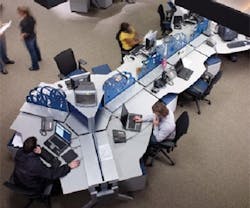While technology impacts how and where we work, it also influences the office environment. "A more remote workforce utilizes less office space," says Terry Carroll, senior product and market intelligence manager for Kimball Office. "Therefore, companies are embracing this fundamental shift to completing work by scaling back on office footprints and demanding flexible, mobile, and scalable furniture solutions, which can be easily adjusted up, down, or reconfigured."
Mobility and Flexibility
As technology becomes smaller and more powerful (your flat-panel LCD computer monitor takes up much less space than your old CRT monitor), the workspace footprint has shrunk, allowing companies to fit more employees into a space. Three or four years ago, 8- by 8-foot cubicles were common, but today 6- by 6-foot cubicles are the norm, according to Carroll.
In addition, employees – and workspaces – are becoming more mobile due to increasing technology. "According to a study completed in 2009, more than 70% of corporate real estate executives have implemented mobile work strategies to boost space efficiency, 71% provide hoteling workspaces, and 75% support working from home," explains Jon Strassner, Humanscale's director of A&D in North America. "Space is more expensive than ever, and technology is allowing us to maximize our use of it."
Worker mobility and the demand for workspace flexibility is escalating and intensifying in order to fully utilize the space. "For example, unassigned workstations with height-adjustable surfaces can accommodate users who only come to the office a few times a week or month," Carroll explains. He cites DEGW, an international workplace consulting firm, saying "Most offices operate at 50% occupancy rates most days, as employees work from home, attend conferences, visit customers, travel, or take personal time off. Workstations are vacant 50 to 70% of the time."
As budgets continue to be a concern, companies don't want to pay for space that isn't being utilized. "The trend moving forward will be to design offices that support this new reality, which means fewer dedicated workstations; more, but smaller, conference and team rooms; and more communal space with soft seating for impromptu meetings," says Carroll. "As the workplace shrinks, many companies will likely move towards table-based benching solutions to facilitate collaboration and accommodate drop-in workers."
Find a Balance
While benching may seem like a viable solution, it raises concerns of its own. "I worry that furniture is getting too mobile and too collaborative," says Strassner.
"We see a lot of benching solutions, which means we also see solutions addressing acoustics and privacy: two not so nice by-products of benching," Strassner continues. "Apple commercials have us believing we can all skip through the office with our iPads and drop into hip lounges to collaborate with other cool employees and their wireless technology while enjoying a double shot of espresso. In reality, though, many workers still need to spend many hours in front of a computer screen, concentrating on solitary work. As mobile as technology gets, I'm not sure the majority of office workers will ever be able to work away from a desk."
When incorporating technology into workspaces, remember to keep the user in mind and find a balance between ultra-mobile, collaborative, and impersonal spaces and personal desking and the privacy of an office or cubicle space.
Technology can help you to maximize your office space, but only if it is incorporated correctly. "Technology has to be programmed into the project, just as you do with green design," says Strassner. "Do not try to design furniture around technology. Provide the most basic horizontal surface for your people, and invest in the proper workplace tools that optimize the interaction between people and their technology."
Kylie Wroblaski is associate editor of BUILDINGS.
